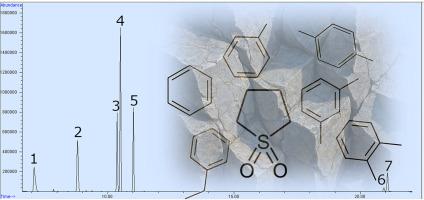气相色谱-质谱法同时分析岩石样品中的亚砜和BTEX
IF 3.2
引用次数: 0
摘要
亚砜是一种与水混溶的工业溶剂,广泛应用于各个工业领域。一旦释放到环境中,它可以渗透到地下水带的裂隙岩石结构中,导致长期污染。在石化工业中,苯、甲苯、乙苯和二甲苯(统称为BTEX)通常与环己烷有关。环砜的存在和迁移会影响BTEX在污染场地的分布和迁移行为。因此,同时分析和监测这些化合物对于了解污染的来源和命运至关重要。在本研究中,建立了气相色谱-质谱(GC-MS)同时定量岩石样品中亚砜和BTEX的方法并进行了验证。为了解决某些样品在甲醇中释放缓慢的问题,并便于快速分析,优化了微波辅助提取(MAE)方法用于样品制备。对加标样品进行分析,各种分析物的回收率为86% ~ 115%,相对标准偏差高达7.9%。然后将验证方法应用于从加拿大阿尔伯塔省中部一个受污染地点收集的岩石样本。所有被分析的样品都被甲苯污染。只有一个样品被发现含有环己烷。乙苯、邻二甲苯、间/对二甲苯和苯的检出率分别为82%、44%、40%和4%。虽然这些污染物的浓度都低于艾伯塔省一级土壤修复指南,但采样只覆盖了有限的深度。因此,有必要进行额外的抽样和调查,以最终确定现场持续污染的状况。本文章由计算机程序翻译,如有差异,请以英文原文为准。

Simultaneous analysis of sulfolane and BTEX in rock samples by gas chromatography–mass spectrometry
Sulfolane is a water-miscible industrial solvent that has been widely utilized in various industries. Once released into the environment, it can infiltrate fractured rock structures in groundwater zones, leading to long-term contamination. Benzene, toluene, ethylbenzene, and xylenes (collectively known as BTEX) are commonly associated with sulfolane in the petrochemical industry. The presence and mobility of sulfolane can influence the distribution and transport behavior of BTEX at contaminated sites. Therefore, simultaneous analysis and monitoring of these compounds are crucial for understanding the source and fate of contamination.
In this study, a gas chromatography-mass spectrometry (GC–MS) method was developed and validated for the simultaneous quantitation of sulfolane and BTEX in rock samples. To address the slow release of sulfolane observed in certain samples when left in methanol and to facilitate rapid analysis, a microwave-assisted extraction (MAE) method was optimized for sample preparation. Analysis of spiked samples yielded recoveries of 86 % to 115 % for the various analytes, with relative standard deviations of up to 7.9 %. The validated method was then applied to rock samples collected from a contaminated site in central Alberta, Canada. All analyzed samples were contaminated with toluene. Only one sample was found to be contaminated with sulfolane. Ethylbenzene, o-xylene, m/p-xylene and benzene were detected in 82 %, 44 %, 40 %, and 4 % of the samples, respectively. Although the concentrations of these contaminants were all below the Alberta Tier 1 Soil Remediation Guidelines, the sampling covered only a limited depth. Therefore, additional sampling and investigation are necessary to conclusively determine the status of persistent contamination at the site.
求助全文
通过发布文献求助,成功后即可免费获取论文全文。
去求助
来源期刊

Journal of chromatography open
Analytical Chemistry
CiteScore
2.50
自引率
0.00%
发文量
0
审稿时长
50 days
 求助内容:
求助内容: 应助结果提醒方式:
应助结果提醒方式:


